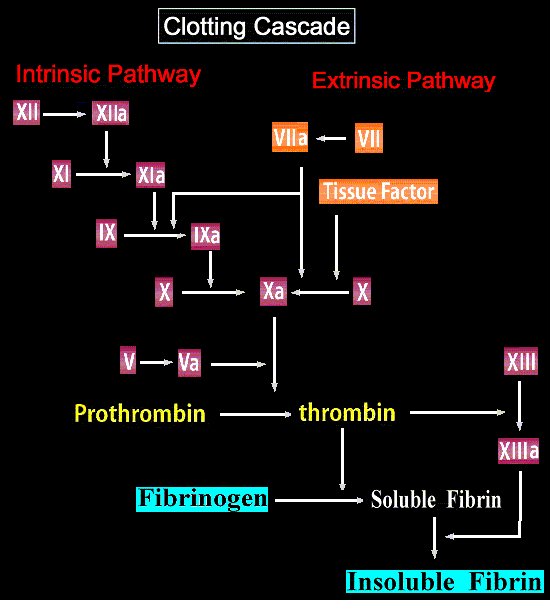| Home |
| Introduction |
| Historical |
| Synthesis |
| Characterisation |
| Indications |
| Blood Coagulation |
| Mechanism of Action |
| Efficacy |
| Side Effects |
| The Future |
| Bibliography |
Blood Coagulation
To understand how warfarin exerts its anticoagulant
effect, a general understanding of the mechanism of blood clotting
is needed.
A blood clot forms as a result of the concerted action of some 20 different substances, most of which are plasma glycoproteins and are designated by Roman numbers.
A blood clot forms as a result of the concerted action of some 20 different substances, most of which are plasma glycoproteins and are designated by Roman numbers.
| Coagulation Factors | ||
| Factor |
Name |
Plasma half-life
(h) |
| I |
Fibrinogen |
72-96 |
| II |
Prothrombin |
60 |
| III |
Tissue Factor or
thromboplastin |
-- |
| IV |
Ca2+ |
-- |
| V |
Proaccelerin |
15 |
| VII |
Proconvertin |
5 |
| VIII |
Antihemophilic
A factor |
10 |
| IX |
Antihemophilic
B factor or Christmas factor |
25 |
| X |
Stuart factor |
40 |
| XI |
Plasma thromboplastin
antecedent |
45-65 |
| XII |
Hageman factor |
60 |
| XIII |
Fibrin Stabilising
Factor |
150 |
| Prekallikrein |
-- |
|
| High-Molecular
Weight Kininogen |
156 |
|
Blood coagulation
represents a series of sequential interactive events that
lead to the repair of the vascular system following injury. The
mechanism is traditionally distinguished in 2 pathways : the intrinsic
and extrinsic pathways. The intrinsic pathway is defined as a cascade
that utilises only factors that are soluble in the plasma, whereas
the extrinsic pathway consists of some factors that are insoluble
in plasma, e.g. membrane-bound factors like Factor VII.
The characteristic feature of the coagulation pathway is that upon activation, the individual glycoprotein serves as an enzyme to convert the zymogen (inactive) form of the succeeding glycoprotein to its protease (active) form in the presence of Ca2+ and an appropriate phospholipid membrane. The activated form of a glycoprotein is identified by the symbol "a".
The characteristic feature of the coagulation pathway is that upon activation, the individual glycoprotein serves as an enzyme to convert the zymogen (inactive) form of the succeeding glycoprotein to its protease (active) form in the presence of Ca2+ and an appropriate phospholipid membrane. The activated form of a glycoprotein is identified by the symbol "a".

The goal of both pathways is to produce Factor Xa, which then catalyses a key transformation : the conversion of Prothrombin (factor II) to thrombin (factor IIa). Factor Xa will catalyse this reaction only if prothrombin is bound to a phosphilipid membrane in presence of factor Va and Ca2+. Thrombin, in turn, cleaves fibrinogen, an inactive circulating plasma protein, to form soluble fibrin monomers. These monomers spontaneously aggregate to form an unstable network.